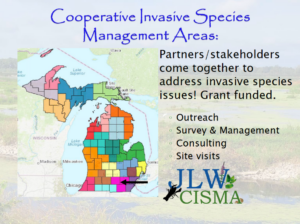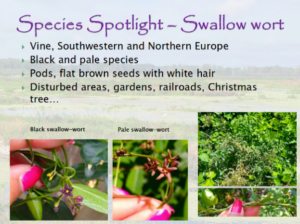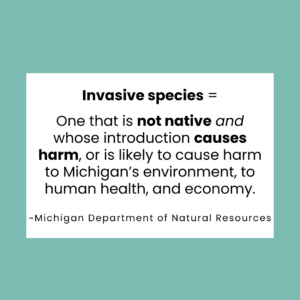By Clint McGill, Legacy Land Conservancy Easement Stewardship Coordinator
For this year’s Land Partner Gathering, we invited Legacy landowners and volunteers to the Legacy office to learn more about some of the undesirable flora and fauna that are in and around southeast Michigan.
Dr. Shikha Singh, Biologist and Coordinator of the JLW CISMA (Jackson, Lenawee and Washtenaw Cooperative Invasive Species Management Area) joined the group over Zoom to talk about the invasive species most common to our region and the ones encroaching on our borders. She highlighted how they spread, their impacts on our environment, and how to stop their spread.
There are 22 Cooperative Invasive Species Management Areas or CISMAs throughout Michigan that are great resources for landowners to learn more about invasive species and how to manage them. But what is a CISMA? It’s a collaboration of local government, tribal, nonprofit, and other community partners that work together within defined regions to address invasive species and their impacts on public and private lands.
 CISMAs are like information clearinghouses for invasive species in Michigan. They bring together folks from state agencies, academia, and local communities to provide landowners with invasive species identification help, treatment options, and other technical assistance.
CISMAs are like information clearinghouses for invasive species in Michigan. They bring together folks from state agencies, academia, and local communities to provide landowners with invasive species identification help, treatment options, and other technical assistance.
By taking a divide and conquer approach, CISMAs are able to take advantage of local partnerships and professionals throughout the state. Experts like Dr. Singh can focus monitoring and management efforts on the highest priority species for their area.
“The aim of the JLW CISMA,” Dr. Singh said, “is to prevent, detect, eradicate and control invasive species in the Jackson, Lenawee, and Washentaw area. By focusing on three counties, we can create a strategic plan for reducing the threat of invasive species, and provide outreach and educational opportunities for local citizens and stakeholder groups.”
It’s no surprise that invasive species pose significant threats to our environment and our local flora and fauna, but they can also lead to serious economic problems. Michigan Food and Agriculture contributes more than $104.7 billion to the State’s economy and ranks in the top 5 in the nation for the production of apples, Christmas trees, and hops. The forestry industry contributes $12.2 billion to the State’s economy and employs approximately 41,000 people.
The approach we take to managing these invasive species can vary quite a bit depending on how prevalent they have become within our landscape, however.
Many invasive species have become so widespread that it is no longer feasible to eradicate them from our landscape entirely. Instead, they can only be managed and controlled on a much more local level. Invasive species like Phragmites (Common Reed), Garlic Mustard, Buckthorn (Common and Glossy), Japanese Knotweed, and Multiflora Rose fall into this category. It may be possible to eliminate these species on your own property with some serious patience and dedication, but it would be incredibly difficult and resource-intensive to do so on a state or county-level.
There are, however, several invasive plants, animals, and pests like black and pale swallow-wort and oak wilt that have only been recently detected in Michigan, and we may still have a shot at wiping them out on a larger scale.
 Black swallow-wort and pale swallow-wort, which are native to Northern and Southwestern Europe, are fast-growing vines that thrive in both shade and sun and are known appear in disturbed areas, gardens, Christmas tree farms, old fields, and alongside railroad tracks.
Black swallow-wort and pale swallow-wort, which are native to Northern and Southwestern Europe, are fast-growing vines that thrive in both shade and sun and are known appear in disturbed areas, gardens, Christmas tree farms, old fields, and alongside railroad tracks.
Swallow-wort vines are particularly bad for a couple reasons. First, their leaves and flowers are toxic to insect larvae. Because swallow-wort is a relative of milkweed, many butterflies and other insects lay their eggs on the leaves. But when those eggs hatch, the only food source available to the larvae is toxic. Unfortunately, 100% of monarch caterpillars die after eating black swallow-wort. Second, the roots are toxic to mammals. Livestock, dogs, or cats could become sick or die if they eat any.
 Oak wilt is a fungal disease that leads to premature leaf drop and crown-balding in the summer. Please note that oaks are relatively easily stressed, so premature leaf drop could be a result of too little water, herbicides, or other local stressors. Sap feeding beetles can spread the disease by carrying spores to nearby trees, and oak trees can transmit the disease themselves via root grafts with other nearby trees. But the primary way oak wilt spreads is people transporting firewood that contains the spores.
Oak wilt is a fungal disease that leads to premature leaf drop and crown-balding in the summer. Please note that oaks are relatively easily stressed, so premature leaf drop could be a result of too little water, herbicides, or other local stressors. Sap feeding beetles can spread the disease by carrying spores to nearby trees, and oak trees can transmit the disease themselves via root grafts with other nearby trees. But the primary way oak wilt spreads is people transporting firewood that contains the spores.
Once an oak becomes infested with the fungus, the tree will die, and there is no treatment to save the infect tree. However, when an oak wilt infection is confirmed on a tree, there are treatments available to save surrounding oaks and stop the spread of the disease. Read more Legacy articles on oak wilt at Reichert Preserve
The fight against invasive species is challenging and constantly evolving, but with support and resources, we can all do our part to fend off these plants and pests that threaten our valuable natural and agricultural resources.
To stay up to date on invasive species and educational opportunities in the Jackson, Lenawee, and Washtenaw County area, sign up for the JLW CISMA monthly newsletter!
To watch Dr. Singh’s full presentation, click here
If you have questions about identifying or managing invasive species on your land, contact:
- Clint McGill, Easement Stewardship Coordinator at Legacy Land Conservancy at [email protected] or 734-780-6167
- Shikha Singh JLW CISMA at [email protected] or 517-395-2089
More Resources:
Michigan Invasive Species Program
Midwest Invasive Species Information Network (MISIN)
CISMA webinar “Not in my backyard! Managing invasives with help from CISMAs”


 RSS Feed
RSS Feed